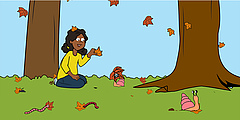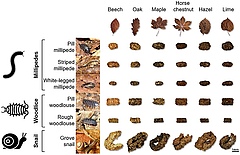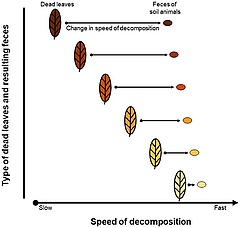The bizarre role of soil animals in the decomposition of dead leaves


Figure 1: (A–C) Examples of soil animals that eat dead leaves and transform them into feces. (D) Example of dead leaves that these animals can eat. (E) Examples of feces from animals that eat dead leaves. (F) The feces of leaf-eating animals are made up of many small leaf particles.

Figure 2: Feces collected from six different soil animals that were feeding on six different types of dead leaves. Feces are drawn to scale but leaves and animals are not to scale. You can see that the color of feces depends on the dead leaves that were eaten, with light color when animal ate beech leaves and darker color when they ate lime leaves. Instead, the shape of feces depends on the animal, with oval feces for millipedes, rectangular feces for woodlice, and cylinders for snails (Image credit: adapted from [5]).

Figure 3: By transforming dead leaves into feces, soil animals affect the speed at which dead leaves decompose. On average, the feces of soil animals decomposed 38% faster than the intact dead leaves did. This effect depends on the type of dead leaves. When animals ate dead leaves that were easy for microbes to decompose (shown in light yellow), their feces did not decompose much faster than dead leaves. However, when they ate dead leaves that were difficult for microbes to decompose (shown in dark brown), the resulting leaf fragments in the feces decomposed much faster.
Open link to original article and PDF in new window.
François-Xavier Joly *1 and Jens-Arne Subke 1
1 Biological and Environmental Sciences, University of Stirling, Stirling, United Kingdom
When plant leaves die, they fall and accumulate on the soil where an important process occurs: they decompose. Decomposition is essential for recycling nutrients and returning them to the soil. It is mainly done by an army of creatures called microbes, invisible to the naked eye, that slowly make the dead leaves rot. But larger creatures, like millipede and snails, also eat dead leaves. These large creatures do not digest these leaves very well and return most of the leaf matter to the soil as poo, which is further decomposed by microbes. Does this transformation of dead leaves into poo affect the recycling process? By collecting poo from many soil animals feeding on dead leaves, we found that they decomposed faster than intact dead leaves. This means that soil animals help the decomposition of dead leaves, not by digesting them, but by transforming them into poo.
WHY STUDY DEAD LEAVES?
Plants are the basis of all life on Earth. Thanks to their leaves, plants can use the energy from the sun to capture carbon dioxide from the air and transform it into sugars. This process, called photosynthesis, is absolutely essential to life on Earth. The sugars are used to grow more plant parts (leaves, stems, roots), which can then be eaten by many different creatures. But a plant’s leaves only live for several months to a few years. When the time comes for plants to shed them, dead leaves accumulate on the soil where another important process begins: dead leaves decompose. This decomposition process is just as critical as photosynthesis, as it allows the carbon that the leaves are made of to return to the atmosphere as carbon dioxide, which can be used again by other plants. Through decomposition, nutrients contained in the dead leaves also return to the soil, where they can be used again by plants to form new leaves. It is only thanks to this fragile balance between photosynthesis and decomposition that the cycle of life continues.
MICROBES DECOMPOSE DEAD LEAVES
How does decomposition happen? This crucial process is mainly carried out by one group of soil organisms: microbes. Microbes consist of fungi—the same organisms that form mushrooms—and bacteria. Microbes are so tiny that they are mostly invisible to the naked eye, yet they are extremely abundant in the soil. Just 1 g of soil can contain 10 billion microbes. These microbes use dead leaves as their food. They digest leaves by releasing many different enzymes into the soil around them. These enzymes are like scissors, cutting the large dead leaves into microscopic bits. Microbes can then digest these leaf bits to get energy and grow. Then, the microbes release the carbon back to the atmosphere as carbon dioxide. The cycle of life can continue.
But microbes cannot decompose all dead leaves at the same speed. Some plants, like pines or beeches, form leaves that are sturdy, quite thick, and poor in nutrients. These leaves are not very good at photosynthesis, but they can survive even in difficult conditions. Consequently, when dead, these dead leaves decompose slowly because they offer few nutrients and little surface for microbes to grow on. On the other hand, plants like ash trees or clover form leaves that are much thinner and have more nutrients. These leaves are less resistant to damage but are better at photosynthesis. When these thinner, more nutritious leaves die, they offer a lot more nutrients and more surface area for microbes, and therefore they decompose faster.
ANIMALS HELP MICROBES WITH DECOMPOSITION
Microbes are not the only soil creatures that decompose dead leaves. Many larger soil creatures, such as millipedes, earthworms, woodlice, and snails, also feed on dead leaves (Figures 1A–C). In some types of forests, and even in deserts, the majority of the dead leaves that fall every year are eaten by these animals [1–4]. However, of all the leaves that these animals eat (e.g., Figure 1D), only a small part is actually digested and used by the animals. The majority is returned to the soil as feces— in other words, poo (Figure 1E). This means that, in ecosystems where these animals are abundant, the main sources of organic matter for bacteria and fungi are not dead leaves, but feces. Regardless of the type of dead leaves eaten, these feces are always much smaller than dead leaves, and they are made of tens of thousands of tiny leaf pieces (Figure 1F). This transformation from large, intact dead leaves into tiny pieces provides a lot more surface area for microbes to grow on and to decompose.
The importance of converting dead leaves into feces is not well-understood. Are feces more easily decomposed by microbes than intact dead leaves are? If so, is this effect more important for thick, sturdy leaves than for the thin leaves that are already easily degraded by microbes? Do all animals that feed on dead leaves help microbes to break the leaves down? In this study, we aimed to provide answers to these questions [5].
THE FECES FACTORY: STUDYING DECOMPOSITION IN THE LAB
To study the importance of converting dead leaves into feces, we needed to find and collect tens of thousands of fresh feces from various soil animals that eat different kinds of dead leaves. This is an impossible task in the wild, because feces are very small and it is impossible to determine the species of animals that produced the feces, or the type of dead leaves that the animal ate. So, we invented a new, special type of experiment: a feces factory. We started by wandering in various forests and grasslands of the Scottish Lowlands, where we collected thousands of soil animals from six species, including three millipede species, two woodlouse species, and one snail species. We also collected dead leaves from six tree species known to decompose at different speeds: oaks, beeches, hazelnuts, maples, horse chestnuts, and limes (Figure 2). We brought all the samples back to the laboratory and, using plastic boxes, we paired each species of animals with each type of dead leaves. In total, we had 36 leaf/animal combinations. We then let the animals eat and, twice a week for 1 month, we collected their feces. These feces were very diverse: they varied in color depending on the dead leaves that were eaten, and they varied in shape depending on the type of animal (Figure 2).
After the feces collection step, we measured how fast these feces decomposed, compared to the intact dead leaves. We wanted to measure this under conditions that other researchers across the world could repeat to verify our results or to compare our findings to those using different animal or leaf species. To do so, we created small, artificial soil systems in the laboratory. We filled small jars with soil from a local field and placed a small amount of feces or dead leaves on top of this soil, separated from the soil surface by a fine mesh. The mesh allowed us to retrieve the remaining pieces of feces or dead leaves easily, but it still allowed the microbes from the soil to move through it and decompose the feces or dead leaves. We placed the jars in a dark, warm, humid room for 6 months. Every week, we added water to the jars to keep the soil moisture optimum for microbes. After 6 months, we retrieved the remaining feces and dead leaves. We dried them, weighed them, and compared the mass of the samples to their starting masses, to tell us how much of the leaves and feces had been decomposed by the microbes during those 6 months.
WHAT DID WE FIND?
Our experiments led to two very interesting discoveries. First, for all the animal species we studied, we found that the feces decomposed 38% faster on average than the dead leaves did (Figure 3). These results were very consistent even though snails, millipedes, and woodlice are very different species. We think that feces decomposes faster because the animals transform the large dead leaves into thousands of small pieces, which are easier for microbes to grow on and decompose. Our second important discovery was that the increased speed of decomposition was not the same for all types of dead leaves. When animals ate dead leaves that were easy for microbes to decompose, their feces did not decompose much faster than the dead leaves themselves. However, when animals ate dead leaves that were difficult for microbes to decompose, their feces decomposed much faster than the uneaten leaves did. Because of this, the big differences in the speed of decomposition between various types of dead leaves nearly disappear once the leaves are eaten by animals and transformed into feces.
SOIL ANIMALS CONTRIBUTE TO THE CYCLE OF LIFE
In summary, by transforming dead leaves into feces, soil animals speed up the decomposition carried out by microbes. This is the reason why we do not see dead leaves piling up on top of the soil, particularly under plants with slow-decomposing leaves. More importantly, by transforming dead leaves into feces, soil animals help the carbon from the leaves return to the atmosphere as carbon dioxide, and help the nutrients return to the soil, where these critical substances can be used again by plants. Thus, soil animals help to maintain the critical balance between photosynthesis and decomposition that sustains plants—and that therefore sustains all life on Earth!
GLOSSARY
Photosynthesis
The process by which plants capture the energy from sunlight with their leaves to transform carbon dioxide and water into sugars.
Decomposition
The process by which complex plant or animal matter is broken down into a simpler form, producing carbon dioxide, and nutrients.
Microbes
Tiny living things, invisible to the naked eye, such as bacteria or fungi. Also called “microorganisms.”
Enzyme
Proteins that can break down large and complex molecules into smaller and simpler molecules.
Feces (fee-seez)
Remains of eaten food that is not digested by animals. In other words, poo.
ORIGINAL SOURCE ARTICLE
Joly, F.-X., Coq, S., Coulis, M., David, J.-F., Hättenschwiler, S., Mueller, C. W., et al. 2020. Detritivore conversion of litter into faeces accelerates organic matter turnover. Commun. Biol. 3:660. doi: 10.1038/s42003-020-01392-4
REFERENCES
[1] Sagi, N., Grünzweig, J. M., and Hawlena, D. 2019. Burrowing detritivores regulate nutrient cycling in a desert ecosystem. Proc. R. Soc. B Biol. Sci. 286:20191647. doi: 10.1098/rspb.2019.1647
[2] David, J. F., and Gillon, D. 2002. Annual feeding rate of the millipede Glomeris marginata on holm oak (Quercus ilex) leaf litter under Mediterranean conditions. Pedobiologia. 46:42–52. doi: 10.1078/0031-4056-00112
[3] Coulis, M., Hättenschwiler, S., Coq, S., and David, J. F. 2016. Leaf litter consumption by macroarthropods and burial of their faeces enhance decomposition in a mediterranean ecosystem. Ecosystems. 19:1104–15. doi: 10.1007/s10021-016-9990-1
[4] Cárcamo, H. A., Abe, T. A., Prescott, C. E., Holl, F. B., and Chanway, C. P. 2000. Influence of millipedes on litter decomposition, N mineralization, and microbial communities in a coastal forest in British Columbia, Canada. Can. J. For. Res. 30:817–26. doi: 10.1139/x00-014
[5] Joly, F-. X., Coq, S., Coulis, M., David, J.- F., Hättenschwiler, S., Mueller, C. W., et al. 2020. Detritivore conversion of litter into faeces accelerates organic matter turnover. Commun. Biol. 3:660. doi: 10.1038/s42003-020-01392-4
EDITOR: Rémy Beugnon, German Centre for Integrative Biodiversity Research (iDiv), Germany
SCIENCE MENTOR: Maria Claudia Segovia-Salcedo
CITATION: Joly F-X and Subke J-A (2022) The Bizarre Role of Soil Animals in the Decomposition of Dead Leaves. Front. Young Minds 10:638736. doi: 10.3389/frym. 2022.638736
CONFLICT OF INTEREST: The authors declare that the research was conducted in the absence of any commercial or financial relationships that could be construed as a potential conflict of interest.
COPYRIGHT © 2022 Joly and Subke. This is an open-access article distributed under the terms of the Creative Commons Attribution License (CC BY). The use, distribution or reproduction in other forums is permitted, provided the original author(s) and the copyright owner(s) are credited and that the original publication in this journal is cited, in accordance with accepted academic practice. No use, distribution or
reproduction is permitted which does not comply with these terms.
YOUNG REVIEWER
JUAN DIEGO, AGE: 15
Hi, my name is Juan Diego, I just turned 15. I am from Ecuador but I grew up in the United States. I have many hobbies. My favorite pass time is playing video games because it allows me to play with my friends now that I am locked in because of the pandemic. I enjoy animals and nature. That is why as part of a school project, currently, I am working on a small stickers book about endangered species
of Ecuador.
AUTHORS
FRANÇOIS-XAVIER JOLY
François-Xavier Joly is a French soil ecologist working at the University of Vienna, in Austria. His research focuses on understanding how soil organisms contribute to the decay of dead plants, and how this process may change due to global changes, such as biodiversity loss and climate change. *joly.fx@gmail.com
JENS-ARNE SUBKE
Jens-Arne Subke is an ecosystem ecologist at the University of Stirling, and is interested in the interactions of plants, soil, and the environment. He tries to answer questions about the way carbon taken from the atmosphere by plants can be stabilized in soils, to reduce atmospheric CO2 concentrations.
